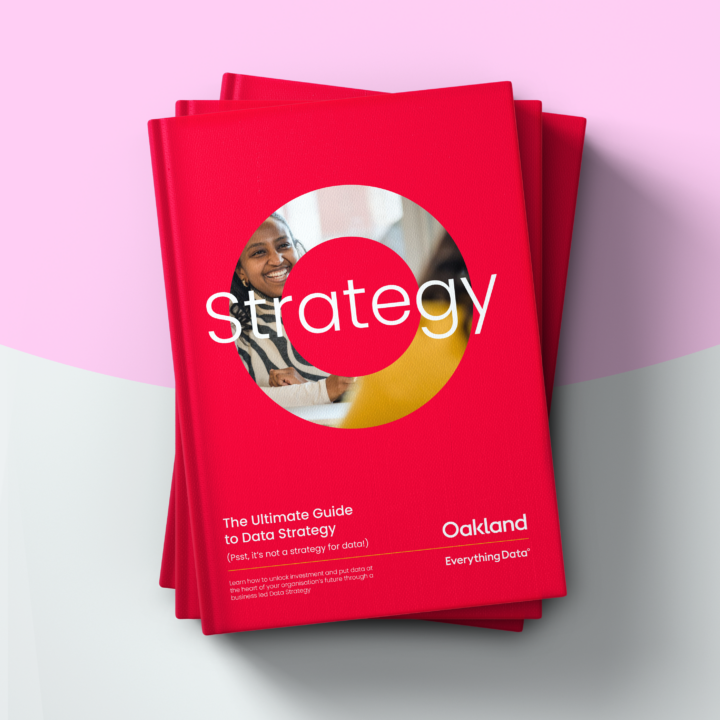Foreword
Data: it’s the best of times and the worst of times.
Over the last two decades, there’s been a huge surge in interest, innovation, and investment in data. It’s hard to find a company that doesn’t want to be more data-driven or a CEO who isn’t interested. Data professionals have never been in higher demand, and new ideas, technologies, and career paths are hitting the market at warp speed. Sounds amazing, doesn’t it? But remember: the data industry is really good at gloss.
The reality for most companies is very different. The chasm between the hype and the reality has probably never been wider. Many businesses are still grappling with the basics.
What can data do for us? Where does this data come from? Can I trust it? Why do we never have the data we need?
If you’re reading this, you probably know what happens when expectations are inflated, or investments are made in tech or talent without anyone stopping to think why.
It’s a dangerous path and it won’t take long for the excitement to give way to frustration. The reality is, you won’t get a return on investment unless you’re clear about what you want to achieve.
Which is why you need a Data Strategy.
If you get it right, a Data Strategy will unify data activity behind a clear vision and case for change which are grounded in the objectives and priorities of your whole organisation.
Drawing on decades of expertise, we’ve honed a practical and successful approach to creating and implementing a data strategy that puts data at the heart of your organisation’s future. Our Oakland approach has been successful across different industries and client organisations, so we’re delighted to be able to share it with you.
If you would like to discuss how we could help you plan, deliver or implement your data strategy, please get in touch, but in the meantime, enjoy the guide!
Joe Horgan
Data Strategy Lead
The Oakland Group
Email: joe.horgan@weareoakland.com
What is a Data Strategy?

In simple terms, a Data Strategy sets a vision, detailed strategy and roadmap which explains how an organisation will use data and analytics to realise its strategic objectives.
A Data Strategy is not about drawing a different future for your organisation, or a standalone strategy that is purely about data. Remember, the wider future of the organisation is (or should be) already imagined through the overall organisational strategy. herefore, a Data Strategy is really about explaining how data can play a key role in the achievement of the organisational future envisaged in the business strategy, and what changes, investments and capabilities are needed to make that happen.
For some businesses their organisational strategy is not well documented or in a state of flux, which can make the process of defining a data strategy a more iterative process involving discovery and re-confirmation of organisational goals. But crucially, this doesn’t change the overall purpose of writing a data strategy.
Done properly, a Data Strategy will unite data-driven activity throughout the host organisation behind a clear set of business-aligned goals, with a compelling vision and case for change to drive engagement and adoption.

This quickly becomes a complex exercise covering a huge range of topics and themes, but when you’re writing a data strategy it’s vital to stick close to this simple purpose.
Remember, it’s data for strategy, not a ‘strategy for data’!
Do we Need a Data Strategy?
Until recently, many businesses didn’t consider the need for a data strategy. However, the explosion in data availability and processing power has created an impetus for organisations to ‘up their game.’
A recurring theme is organisations skipping over data strategy and leaping straight into technical implementations. This results in technical and business upheaval as new technology get introduced with a localised short-term mindset instead of a longer-term strategic perspective.
If you want to succeed, it’s vital you start by thinking about the challenges and opportunities you’re facing.
Do any of these statements sound familiar?
“There’s an opportunity in here somewhere”
Very often organisations have a sense that they are missing opportunities to use data better, but are struggling to identify how. A structured data strategy design will uncover and prioritise the relevant opportunities.
“We need to set a vision”
One powerful benefit of a data strategy is that it creates a clear future to unite efforts and guide decision-making. Sometimes this needs creating from scratch; but in other scenarios we find it’s more about helping to better structure and articulate existing thoughts.
“Everyone’s doing their own thing”
Many organisations suffer from disjointed data functions and activity. Accountability may be disperse or budgets and decision-making rights are withheld or non-existent. A data strategy will align priorities, resources and roadmaps behind a clear vision.
“Where’s the ROI?”
A very common challenge. Either investments have been made which are not showing the expected benefits, or data sponsors and leaders are struggling to secure budget and resources to execute their ideas. The root cause is often a lack of a clear underpinning strategy.
“The customers have had enough”
Scratch below the surface and data ‘customers’ (internal or external) are often a frustrated bunch. Availability, access rights, quality and timeliness of data are all perennial frustrations. An effective data strategy harnesses these pains, identifies root causes and mobilises investment in solutions.
“Our house has no foundations”
A frequent refrain from anguished data leaders. The key challenge is helping link customer frustration (“the dashboard is wrong”) to root causes (“nobody owns the data”) to solutions (“we need data governance”). This is about linking data management best practise with a narrative that is grounded in day-to-day data customer challenges.
“We’re stuck in a reactive cycle”
Many data teams become trapped in urgent demands, re-work and improvisation. This is a draining environment and can prevent any long-term capabilities or enduring corporate knowledge from emerging. A collaborative process to define and implement data strategy helps break this cycle.
Every business will have their own reasons, but if some of what you’ve just read sounds familiar, there’s a good chance you need to consider creating or updating a data strategy for your organisation.
What’s next? Well, starting with the right mindset and approach is crucial. In the next section we’ll take you through one fatal mistake to avoid and show you how to find a better way to tackle writing your data strategy.
Finding the Right Approach
What not to do
Bear with us. It sounds strange, but a data strategy shouldn’t be a strategy for data.
It’s so easy to fall into the trap of thinking of data as something separate from the wider organisation, with its own priorities, objectives and concerns. But this is a fatal error.
Take a look at this. Where would you say you are today?
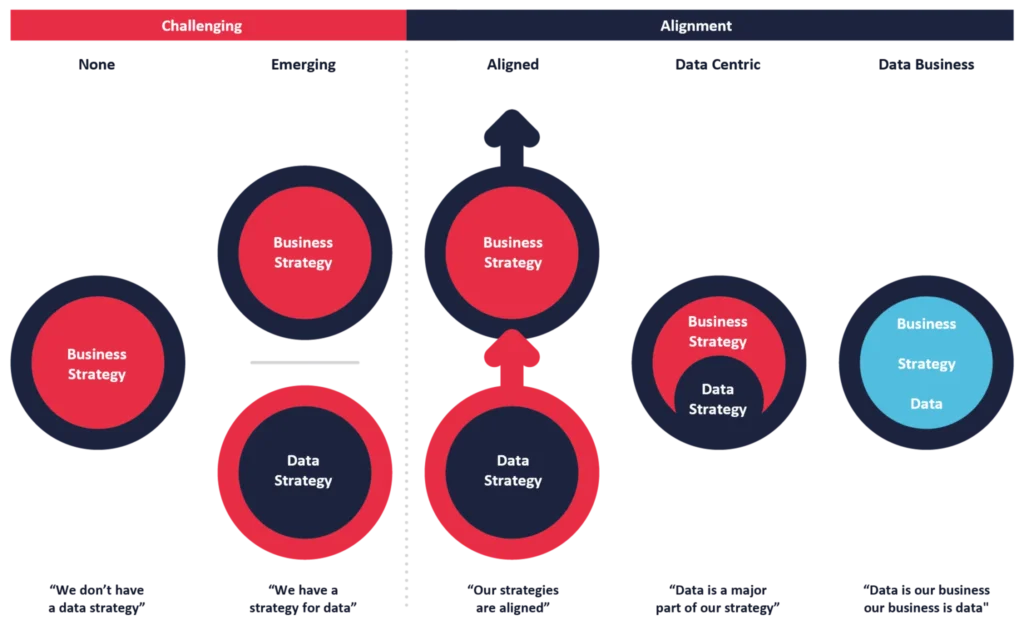
Sometimes we meet organisations with no real data strategy at all. But most of the clients we work with do have a data strategy. The problem is they are stuck in the ‘Emerging’ state.
This means they’ve put a strategic lens on data, but only from the perspective of data and the data team(s). This usually results in a data strategy that’s internally facing, tech-heavy and leaves the rest of the organisation grasping for the ‘so what?’.
This means interest, momentum and (crucially) resources are never secured. The data strategy goes on a shelf and things carry on exactly as before. The organisation might be able to say ‘we have a strategy for data’, but none of the expected benefits have materialised.
A better way
So how do you avoid the ‘strategy for data’?
Well, nothing will change until you put the organisation and its overall strategy before the data. Data needs to be re-cast as a means to meet organisational needs, not an end in itself.
Many organisations struggle with this shift. Even when you have moved your mindset, you can easily get stuck.
It’s complex because every data strategy needs to be custom-shaped to your organisation. You can’t cut corners with ‘cookie-cutter’ blueprints. (Well you can, but it won’t end well.)
However, you can apply a structured process to help you and your team discover, design and deploy a compelling data strategy that creates a path from where you are today to a data-driven future.
Sadly, most data strategies fail to create that path.
If you want yours to be one of the ones that succeed, here are four key principles to stick to.
1. Data is business and your business is data
The question is not “what’s our strategy for data?”, it’s “how do we use our data to achieve our strategy?”. In this context data becomes the ‘how’, or one of the planks in the bridge between the your today and the future envisioned in your organisational strategy.
The starting point for your data strategy is to therefore understand:
- What outcome(s) does our organisation need to achieve?
- What is the role of data in that journey?
- How will business value be created?
With business value and critical results in sight, you can identify and prioritise the required capabilities.
2. People, Process and Technology
The modern data strategy requires a balanced view incorporating people and process elements, such as culture, experience, policies, and behaviour alongside technology.
Historically, many organisations have over-invested in data technology and talent without enough emphasis on culture, governance and process.
A better way of looking at the problem is through the lens of capabilities. What does your business need to be able to do with its data?
Buying technology or talent is inherently transactional and narrow in scope. Creating capability requires a carefully balanced orchestration of people, processes and technology. It opens up a much wider perspective for a data strategy and avoids the pitfalls of scattergun hiring or pursuing technology for technology’s sake.
3. Stories not sermons.
‘Oh fantastic a fifty-slide presentation about data mesh, let’s extend the meeting!’ Said no CEO. Ever.
Too many data strategies are long, technically focused and leave their audiences cold.
Any effective data strategy must have a compelling narrative. Writing and implementing a data strategy is, fundamentally, a storytelling challenge.
It’s easy to get lost in a maze of frameworks, jargon and detailed arguments. But for the non-technical folk who are the majority of your audience, you need to find a compelling way to tell three interrelated stories:
- The value story: how will the organisation create concrete value from data against its strategic objectives? What are the opportunities people should be excited about? It’s a realistic but exciting vision of how data can drive a better future rooted in the concerns and self-image of the host organisation.
- The data management story: this knits a vision for how the organisation will collect, store, organise and safeguard its data. It’s as much about ownership, care and ethics as it is about lakehouses and ELT. It’s crucial to link in to the data value story and position data management as key to realising that value.
- The data culture story: this is so often overlooked, but oh so vital. How do we cultivate the right behaviours and values towards data in the host organisation? What should people think, feel, role model and advocate? What are the different organisational roles and personas?
The point here is not to produce a mini-series of paperbacks and leave them strategically placed around the office canteen and boardroom.
It’s about ensuring there are compelling, accessible and coherent narratives woven through the whole design, presentation and implementation of a data strategy.
Data strategy storytelling could be a guide like this all on its own. But, briefly, at Oakland we like to follow an approach based around what we call ‘the 7Cs’. Follow these and you shouldn’t go far wrong:
- Customer-Centric: it starts with the customer’s pains, and ends with their benefits
- Commercial: we focus on the tangible value we can add, not complex methods
- Context: a vision grounded in organisational reality, not the textbook
- Concise: short, focused messages that are easily consumable
- Concrete: practical examples or case studies in accessible language
- Creative: visual representation of complex concepts and relationships
- Conversational: stories emerge from a two-way dialogue with stakeholders
4. Co-discovery and creation
At Oakland, we think data strategy should be an outward-facing, whole-company effort.
Your data strategy is a shared document that sets out how the organisation plans to use one of its most important assets. It should grow out of workshops, customer engagement and deep analysis of the needs and personas of the host organisation. The final presentation should not be a ‘big reveal’; you MUST work collaboratively.
A different way
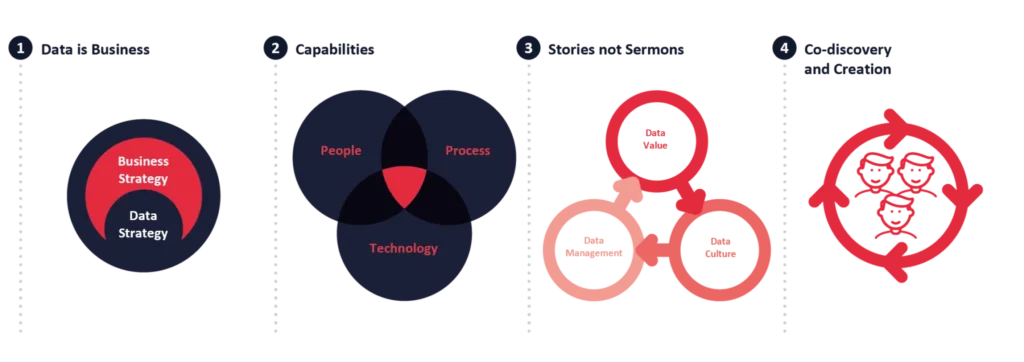
When you put those four principles together, a very different way of looking at creating a data strategy emerges. This is what allows you to escape the ‘Emerging’ state that many data strategies become stuck in. It’s an approach that unlocks a whole new range of possibilities for data, and positions it as a critical organisational capability, not a standalone technical domain.
What should be in your Data Strategy?
Many data strategies are only partial answers. So you need to make sure you have everything covered. When crafting your data strategy, you need five major components:
- Strategic vision – the broad brush of what you want to achieve and the high-level changes that are needed to make that happen. This needs to be a compelling vision of a better future and the big-picture changes needed to make it happen.
- Case for change – the challenges with your current state and what’s in it for the enterprise if you deliver on the vision. This needs to strike a balance between the challenges of today and the benefits of the future painted in the strategic vision.
- Detailed strategy – a richer picture of what the future will look like covering: enterprise value delivered, target state capability, alignment of delivery resources, and governance of implementation. Turn the vision into detailed components for implementation.
- Strategic roadmap – the transition phases and change activities your organisation will undergo as it moves through implementation and stages of change
- Target Operating Model (TOM) – the build-out and organisation of data capabilities to deliver the strategy. The translation of the strategy into organisational reality.
Each component plays a crucial role in driving the realisation of the value of data in your organisation.
1. Strategic vision
Your data strategy should provide a clear view of how data will become a key engine for the wider organisation as it drives towards its strategy. It’s where you paint the big picture of a different, data-driven future for your company. The three organisational data stories and our ‘7C’ storytelling principles have a critical role to play in this part of your strategy.
Key elements to include in your vision are:
Purpose
What place does data have in your organisation, and why is it vital you think about it differently? Finding ways to connect this back to your organisation’s broader business purpose and strategy will be critical, as it cements the foundation of data.
Scope
What’s the scale and content of your strategy? Your scope definition should also clarify what the broader organisation understands by the term ‘data’.
Future
What are the big-picture changes and benefits you want to bring about through the realisation of the strategy? What will be different when the implementation has occurred?
Objectives
What things will we be able to achieve as an organisation as a result of the data strategy? Goals should be tangible for the business and aligned with overall business objectives. Expressing (in simple terms) how the data strategy achieves each business objective will aid the communication and buy-in of the roadmap.
Key results
When we have achieved (or are approaching) our objectives, what metrics will we influence, and what will those look like? As with objectives, it is best to express these with key business metrics.
Capabilities
What (at a high level) will we be building or enhancing in our organisation? This section sketches out the capabilities that need to be created, developed or overhauled. How will people, process and technology be combined to create new possibilities for the organisation?
Every vision will be different, depending on how ambitious or transformational you to be. To find the right balance, you must be mindful of your current data maturity. It’s tempting to shoot for the moon but winning support by tackling an immediate problem can help you create a successful launchpad for a more ambitious data strategy.
2. The case for change
Your case for change should present a straightforward and compelling rationale for why your organisation should pursue the strategic vision of your data strategy.
Translating the vision into action demands significant buy-in. The case for change will make or break your data strategy. So take the time to get it right.
Your case for change must meet people where they are at and how they think. It must resonate equally with the ‘big picture’ visionary, the execution-oriented process manager, the numbers geek, and the people person. This is a storytelling challenge: the narrative must be strong.
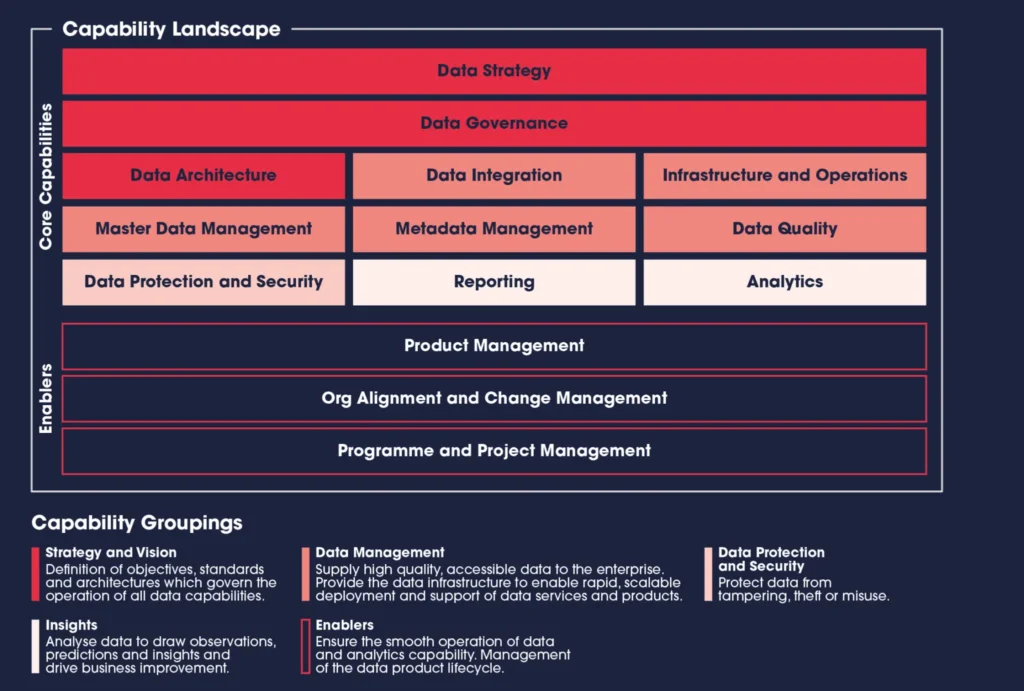
The following elements are critical:
Clear view of today
This should be an unbiased and critical look at how your organisation delivers data and analytics today. When doing this for our clients, we typically leverage a maturity assessment against our data and analytics capability model. The critical question is: “is this fit for purpose?” If not, why not?
Voice of the customer
Maturity assessments are only part of the puzzle, so we enrich them with clear explanations of real-world data problems and aspirations from the customer community. Customer-engagement is non-negotiable when creating your case for change.
View of target
Leveraging the capability model above, we can set a data maturity target for the future. In most cases, organisations will look to move up 1 or 2 levels in maturity over the lifespan of a data strategy. Crucially, maturity increases need to clearly tie back to the underlying business needs identified in your data strategy.
Business and financial rationale
This is essential but, we know, often difficult. Sometimes, there may be a directly identifiable uplift in profitability based on the data strategy. In other cases, data can support benefits realised elsewhere. However you do it, make sure your assumptions are clear and agreed on.
The depth of your case for change depends on the size of transformation you are aiming for as well as the number (and type) of stakeholders you want to get on board.
Data is a nebulous space for many stakeholders. It can feel confusing, disruptive and uncomfortable for those who don’t understand its aims. So, think of your case for change as a process of education and joint discussion rather than just a one-off document. Whilst it can feel frustrating if stakeholders don’t ‘get it’ at first, the effort and patience you put in at this stage will pay huge dividends later on. If you keep listening and keep responding, you will get there!
When you have a strong coalition on board to deliver on your vision, it’s time to get into the detail.
3. Detailed Data Strategy
This is about adding the detail to your strategic vision so that it becomes implementable into your organisation. You need to paint a more specific picture of how the future will be different, and the key shifts involved in getting there. So, you will want to focus on a few areas of detail to gain alignment and agreement on key questions:
Future state definition – the forward-looking view of the maturity assessment and wider diagnostic work you did as part of your case for change. What are the specific ways in which the data future of your organisation is different from today? How do they deliver the benefits laid out in your vision and case for change? In some cases, you may want to grow maturity in one aspect or capability of data more than others, so identify where those differences exist and call out the rationale. Be sure the improvement you want to develop matches your organisation’s ambition. The future state definition should relate back to your vision and case for change, but also build out the next level of detail. Once you have that definition in place, you can move on to…
Concept design(s) –these are high-level views of the future from a data and analytics operation, data governance, and technology point of view. Providing a clear view of the future and getting alignment early helps to drive out more detailed design. This can take multiple forms depending on the focus areas for your strategy. To help bring this to life, below is a concept design which aligns components of a data organisation behind clear delivery streams and consumption methods which tracks value delivery right through to end users.
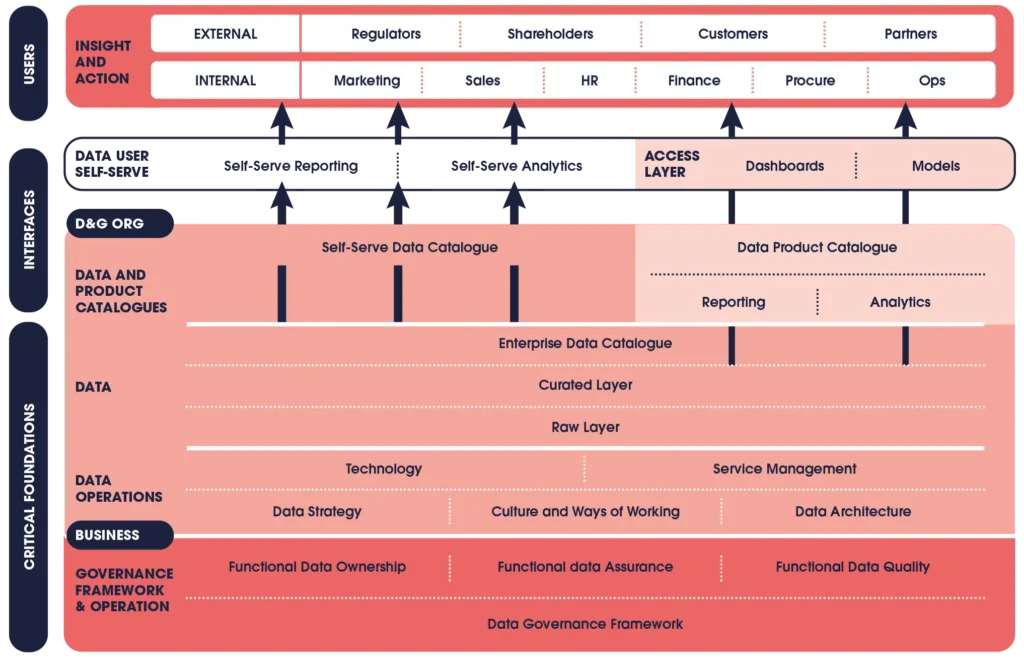
You can also imagine concept designs of future data flows, data governance frameworks or platform architecture. The point here is to put together some clear pictures behind the future state definition so that stakeholders can see how the components of the future fit together.
Levers of influence– an overlooked aspect of most data strategies. You need to identify what the strategy can influence and, crucially, how it will be implemented. Think of this as a template for how you will deliver organisational change, with a heavy focus on aligning people. A figure of 8 change model like this one below will help guide your thinking and, crucially, shine a light on the content and deliverability of your future state vision.
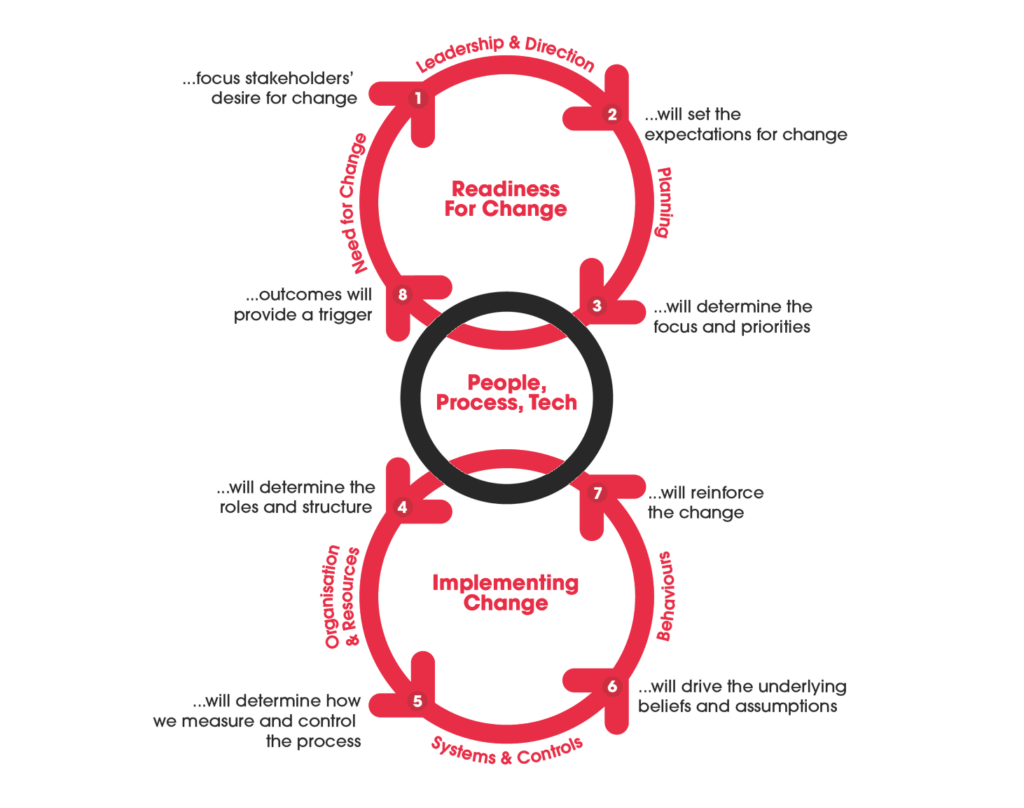
Key gaps to close – By now, you will have charted out your organisation’s future state data and analytics capabilities. Still, there will be gaps that need to be closed before you can deliver on the strategy. Documenting these gaps within your strategy is essential for starting a chain of accountability for getting each gap closed. You will need to establish what gaps will be addressed within the scope of the data strategy and what is out of scope but dependent on other parts of the organisation.
Building upon the items above to create a detailed data strategy is a valuable tool to take the high-level vision you have for your organisation and set out the practical components necessary to realise that vision.
Then it’s time to think about the planning necessary to move your strategy from a paper-based concept to organisational reality.
4. The Strategic Roadmap
By this stage, you’ve pulled together:
- Your vision
- Why your organisation should implement the vision
- The details of what the vision entails
The inevitable response will be:
“How long and how much?”
The cornerstone of your data strategy will be the strategic roadmap for developing the capabilities provided as an outcome of your data strategy.
The detail in your roadmap components will vary depending on the scale of intended change. Regardless of the detail, here are some areas you may want to include:
- Overarching 2-3 year roadmap – It’s difficult to predict the future, so your roadmap needs to be ambitious enough to account for the likely shifts in your organisation’s various operational and strategic contexts.
- Transitional states – How does your strategy build over time? Clear transitions help to create buy-in for change and make it easier to sequence your roadmap.
- Projects on a page – Implementation will likely take the form of various distinct projects within the roadmap. Crafting a high-level view of scope, activity, and potential resource requirements on a single page will bring these efforts to life.
- Governance – Outlining who will oversee the data strategy, the reporting structure, and how they intend to govern the program is crucial
By this stage, you have outlined your data strategy roadmap and explained the value of each component.
The next step is to build a Target Operating Model (TOM) – the blueprint for how the business will operate with its new data capabilities.
5. Target Operating Model (TOM)
A data strategy provides the shape of where you are going, and you roadmap should include specific changes or programmes to deliver on your strategic agenda. These strategic projects implement your strategy as a series of key initiatives, targeted at major gaps or key themes.
However, these projects might not touch on every area of a data organisation. Further, they’re unlikely to fully define how the organisation operates its new data capabilities as BAU.
Further, without careful alignment, much of your current organisational set up and ways of working might actually be working against your strategy. There might be a strategic vision, but if the day to day reality is one where ways of working are unchanged, then delays and internal friction will dominate the data customer and employee experience.
The solution is to define a new Target Operating Model to support your data strategy.
Far more than an organisational chart, your TOM will describe the people, processes and technologies required for delivering value from data within your organisation. If describes how you will organise to deliver the data and analytics capabilities in your strategy through a number of critical components:
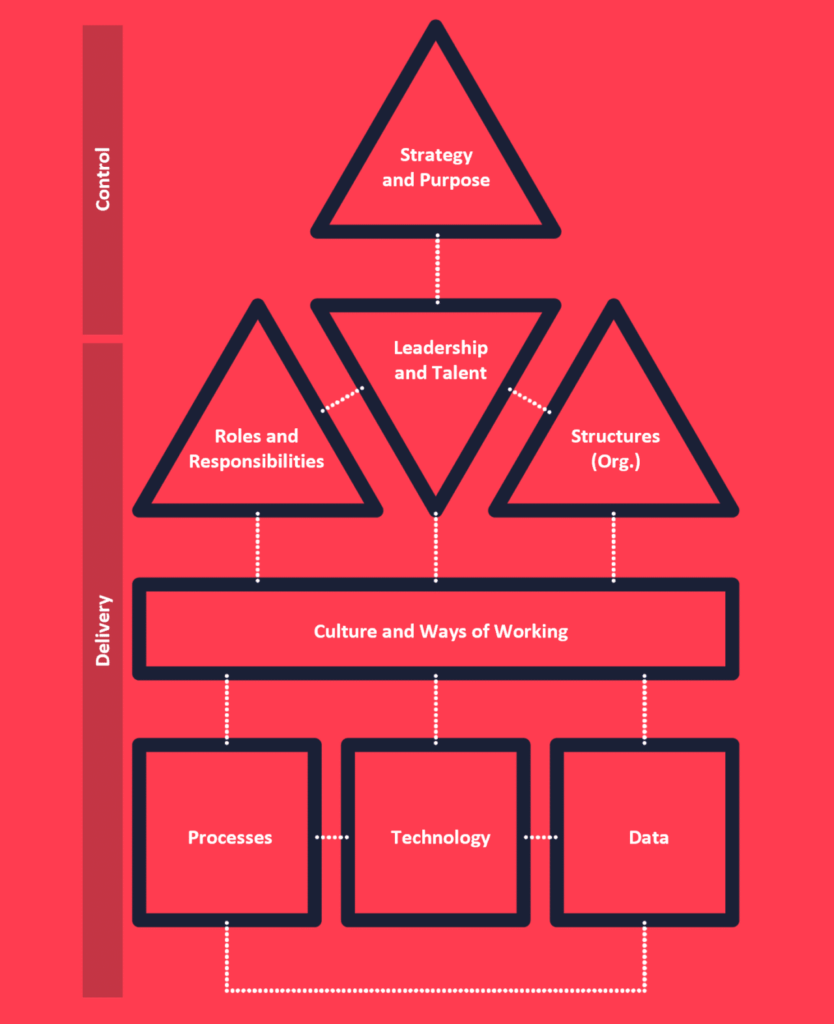
In our experience, you need a joined up design spanning all of these for you to fully design a TOM that delivers on your strategic vision.
We recommend starting each at a conceptual level to gain buy-in. Once you’ve got broad agreement, you can move into detailed design and execution of your future operating model f. If you get this right, you will have deeply embedded your data strategy in to the very fabric of your data organisation.
How to Phase your Data Strategy
So far, we’ve outlined what to include in your data strategy. It’s a big task. Breaking it down is key to success.
This section summarises how to do that and work through the process of designing a data strategy, along with important questions to consider at each stage.
Phase 1: Discover
The goal of the discovery phase is to understand the baseline of where you are today and where you want to be in the future with data and analytics.
Critical questions include:
- What is the current maturity of your data capabilities? What is the perception of maturity across different stakeholder groups?
- What is the experience of data customers and what are they looking for in the future?
- What strengths and weaknesses exist in the current operating model?
- What are the organisation’s key strategic goals, and how can data and analytics be leveraged to drive towards them?
- What is the vision for the future of data and analytics? How can that be translated into specific, measurable goals?
- What is the case for change? How should it be communicated?
Phase 2: Define
In the define phase, you will develop the outline of the data capabilities that align with the vision for data across the organisation.
You will be defining the concepts and interactions that shape the future of your data strategy and operating model (e.g. strategy and purpose, value streams, process architecture, ownership and roles, functional boundaries, leadership and culture).
You will also define the target and key results from a business perspective.
Common questions are:
- What future state design principles will act as a yardstick for the success of the strategy?
- What strategic questions and trade-offs will shape the future data strategy?
Phase 3: Plan
In the planning phase, you will establish the processes, standards, technology, and organisational changes required to deliver the vision.
You will also create a supporting transformation programme to deliver on the ambition, including a detailed design of the future strategy and operating model for data.
Essential to the planning activity is understanding what enablers need to be in place to execute your vision (e.g. stakeholder support, investment cases, technology implementations, training).
Some of the standard planning deliverables will include:
- Strategic roadmap and transition states
- Success factors and measurement framework
- Programme mobilisation
- Change management and risk control
Phase 4: Execute
Here you will deliver the transformation across the enterprise in an iterative fashion, gathering lessons along the way to adjust delivery.
The typical programme execution activities we execute during this phase include:
- Programme management and change delivery
- Communication and training
- Project control and assurance
- Implementation monitoring and feedback loops
Phase 5: Adapt
Data strategy programmes are never a straight line – there are always twists and turns along the way.
We recommend adding an adapt phase that can flex to meet the shifting demands of the business and the many changes, opportunities, and obstacles your data strategy programme will invariably encounter.
You can sustain the delivery of change in the organisation by embedding principles of continuous improvement aligned with key performance indicators, such as:
- Continual monitoring and adaptation of implementation
- Transition and support for a sustainable future (not cut and run)
- Monitoring and assurance of delivery and benefits
What challenges might you face?
Here are the most common challenges we have learned to expect and prepare for through our many years of building data strategies:
Understanding
Many stakeholders’ hopes and dreams (or their doom and gloom) will go into your data strategy. Not to mention their expectations for what outcomes the programme will deliver. So, when communicating, make sure you set realistic expectations.
The many misconceptions and misunderstandings about data will likely be your biggest people hurdle. Data and analytics is a broad profession, so you’ll need to create a comprehensive education plan. A robust current state assessment can help, but you still have to deliver considerable educational resources and stakeholder sessions to build up the baseline of knowledge.
Engagement
This can manifest in several different ways:
- You need to speak with stakeholders, but they aren’t available.
- You want to build buy-in for the strategy but cannot get time with resistant individuals.
- You need external support to build the strategy but cannot get the budget.
Even before the strategy development effort begins, there is a lot of groundwork to ensure you will get the right resources at the right time. One tactic we find successful is to chunk up the work (with our phased approach) and not move on to the next phase until you have the necessary engagement.
Demonstrating tangible ROI
Business case assumptions can be rock solid or flimsy as paper.
The data strategy capabilities you create are typically enablers of the wider organisation rather than drivers of increased revenue or massive cost reduction. Be upfront about these challenges with stakeholders and focus on where better data and analytics can best drive financial improvement.
The implementation long haul
You will need to lay the groundwork of expectation that there will not be a quick fix, especially if your strategy is transformative. Planning should look to define clear transition states, as these offer an opportunity for the organisation to adjust the roadmap and celebrate how far it has come.
How can Oakland help?
Data Strategy Experts
Wherever you are on your data strategy journey, Oakland can help you make the next step.
We offer a range of customisable services which span the entire data strategy lifecycle.
You can choose to engage us at specific points on your journey, or we can partner with you through the entire process of defining and implementing your data strategy.

1. Diagnostic services
An effective data strategy design must have a clear picture of the current state of an organisation’s data capability.
Our diagnostic services are designed to carefully analyse and summarise the current state of data at your organisation.
These services are available as part of the ‘Discover’ phase of a wider data strategy design or as standalone advisory services:
- Data Maturity Assessment. Using Oakland’s detailed data capability framework we can provide a complete evaluation of your current state data capabilities Summarised in a detailed report, we provide maturity scores and supporting evidence as well as a clear assessment of whether your current capabilities are fit for purpose to serve your expected organisational needs.
- Data Culture Assessment: using our detailed data culture framework, we take a detailed look at the wider environment and ecosystem for data in your business. This is about understanding the beliefs, skills and decision making styles that exist in your company and considering their fitness-for-purpose in the context of your strategic objectives. We’ll translate that analysis into a vision and supporting action plan to drive a data-driven culture in your organisation.
- Data Strategy Review: if your organisation already has a current or planned data strategy, our experts will provide a complete end-to-end review of your current data strategy to highlight gaps, opportunities and implementation risks. These reviews are benchmarked, peer-reviewed and assessed against our suite of data frameworks and delivery tools as well as years of experience and industry best practices.
It’s important that diagnostic service(s) are tailored to your needs. These services can be bought individually, in combination with each other or even as a complement to other focused diagnostic studies (e.g. a data platform assessment).
2. Data strategy design and implementation
If you need us, we’ll support you throughout the discovery, definition, design, implementation and monitoring of your data strategy. Or, if you’d prefer, our experts will help you flesh out specific parts of your data strategy: for example, we can help you craft a compelling strategic vision for data to mobilise investment, or build out a strategic roadmap to support your existing strategy.
We can tailor scope, timelines and team composition to your needs because we know that every organisation is different. Our experts put decades of experience at your disposal, alongside the powerful frameworks we’ve shared in this guide.
3. Target Operating Model (TOM)
Without a supporting operating model design, data strategies can struggle to deliver sustainable change as long term BAU.
Not all “operating models” are created equal. When we say TOM, we mean much more than drawing up some organisational charts or dashing off a quick architecture sketch. It’s about defining the fundamental way in which your data team(s) deliver value to the organisation and the capabilities you need to do that. Using tried and tested frameworks and delivery tools, our experts can support your data strategy with complete end-to-end design and implementation of a TOM to make your data strategy an organisational reality.
4. Strategic advisory
For clients who want access to insights and expertise in data leadership and strategy outside of creating or refreshing their data strategy, we offer a flexible strategic advisory service which puts our experts at your disposal for as long as you need them. Whatever your needs, our experts will still bring the tools, frameworks and experience that they would to any other data strategy engagement.
Client Stories
Yorkshire Water
Enterprise Data Transformation

The challenge
Yorkshire Water has historically faced similar pressures and demands to many other utilities, such as aging infrastructure, cost pressures and high demand for reliability in their core services.
What they needed
Yorkshire Water has long realised that data is a core asset in helping to address the above demands. This need to utilise data assets to help exploit and capitalise their physical assets has led Yorkshire Water to undertake a complex, multi-year data transformation.
What we did
Based on our track record of successful delivery, Yorkshire Water has invited Oakland into a minimum one-year agreement help them to plan and execute across a broad set of areas within their data transformation:
- Data strategy evolution and enterprise-wide Target Operating Model (TOM) for data and analytics.
- Defining and implementing an enterprise-wide data governance framework and associated capability.
- Extending and evolving Yorkshire Water enterprise architecture to help support and deliver enterprise-wide data analytics.
- Provide architectural, engineering and data science capability to build a telemetry platform and associated predictive models to forecast and predict leakage.
The results
Oakland is busy delivering critical milestones against each of the data transformation streams in what has been a cultural sea change for data within Yorkshire Water, as Andy Crossley explains:
“A lot of the earlier data work undertaken within Yorkshire Water was tactical, but as a result of the data transformation journey, the internal business, data and technical communities have rightly recognised that Yorkshire Water urgently needed a more mature, strategic view of data.
The data transformation streams are rapidly delivering the mature data fundamentals critical to the growth of an innovative and progressive information-driven enterprise.”
–Andy Crossley, Oakland Group Director
Initiatives such as data quality improvement, data governance and enterprise data architecture, not to mention the strategic data platforms and data science solutions, are transforming data capabilities into positive business outcomes for Yorkshire Water.
Infrastructure management, cost control, and reliability performance have benefitted dramatically from the results of the data transformation program, with data enablement activities helping to drive an overall business transformation ROI of £150m+.
Kaplan
Improving Data Capabilities

The challenge
Seeking to quickly build up a new Apprenticeship business to complement their existing offering, our client faced a pressure on data, from entry to usage. To achieve their business aims, the client acknowledged the need to improve their data capabilities to allow them to:
- Combine more data from siloed specialised systems
- Clarify sources of truth and define a common language and glossaries for their data
- Improve data quality and control
- Manage data demands
Before Oakland engaged, existing discussions were focusing on systems such as: “we need a CRM”. We helped our client to look through the lens of data: what do we have? Where’s it stored? Can we use it? What capabilities do we have?
What we did
Phase 1: Data Discovery
Oakland started by helping the client with a comprehensive assessment of the current situation:
- Mapping existing data alongside business capabilities
- Rapid data capability assessment: using our Oakland maturity model, we positioned each capability against an as-is baseline and quickly assessed data quality for the largest critical data sets.
This as-is picture was based on interviews and reviews with stakeholders across departments. From this current picture, we derived a set of themes to explore. Hosting a workshop per theme, such as ‘Data Entry’, ‘Data Architecture’, ‘Data Governance’, or ‘Data Offense’ we raised awareness, assessed needs and set shared priorities
Through these engagements, we did not just shape the vision, we also created a strong consensus between team members. We were then ready to move in to Design and Plan activity for the future data strategy.
Phase 2: Data Strategy Design and Planning
It was clear that the data strategy had to be comprehensive. But before going in the details of what a target should look like, we wanted to be led by value.
In a joint working session, we worked as a team to define the expected results and contribution over multiple time horizons and business outcomes.
Then, for each strategic theme there was a phase of deep dive investigation, options identification, and creation of recommendations. As we progressed on each topic, we constantly tailored principles with our client: dropping elements that were not a priority and aligning the roadmap with the sense of urgency and appetite for investment.
At this stage, we identified and addressed all the little things that makes a strategy a success. Elements such as business glossary templates, roles description, steering terms of reference, or illustrative processes were shared to make the strategy real. With clarity in mind, the client identified quickly which model was the most appropriate for them – a centralised model with domain driven data governance.
The results
Following our strategy engagement, our client now has a vision, a target and a plan. Just as importantly, the client gained understanding and knowledge of how to work with data and what are data capabilities required. With the key results in sight, there is a shared understanding of what can be achieved, which defined the level of capabilities and investment required for our client to fully exploit their data.
Crucially, the Data Strategy has been approved by our client’s CEO and board, with the recruitment of new roles and the implementation of strategic initiatives to make this strategy a reality now underway.
Final Words of Advice
Creating a unified vision
Having a data strategy allows you to unite and catalyse activity behind a single, compelling vision for how data can be leveraged to meet your organisational goals.
Yes, it’s hard, but it’s worth it.
Here’s some final pointers to consider before moving forward on your data strategy journey:
Collaborate, collaborate, collaborate: your data strategy should reflect the goals and ideas of your entire organisation. Fundamentally, it’s a shared document that sets out how the organisation plans to use one of its most important assets to achieve its critical goals. Working collaboratively and giving your stakeholders a chance to shape what’s emerging will really pay back in terms of engagement.
Take your time: the opportunity you’re seeking is huge, but a good data strategy needs time and space to emerge. A poorly crafted strategy will do more harm than good. It will use up finite patience and sow confusion. So, make sure you have the time and resources ready before committing.
Focus on what your company needs: there’s a lot of people who will tell you (usually from the safety of the internet) that they have the one big idea that will solve all your data problems. Our advice would be: avoid those people like the plague. All organisations are unique, and all data strategies should be unique to their host organisations. Focus on what you know about your organisation and where you need to get to, not trying to bend the facts to fit a pre-conceived silver bullet.
Keep it real: writing a data strategy can seem like a tall order. It makes some people think they must come up with something startlingly original or devastatingly abstract. Well, the good news is you don’t have to do that at all. Unless you are working at the absolute cutting edge, then most of the ideas you need are already out there. The key is to select the right concepts and approaches and stitch them together into a well-grounded plan than can win organisational support.
Keep the value flowing: stakeholder patience is finite. You won’t get 3 years to come up with the right answer and build it. Engagement and momentum are the fuel of data-led transformation. So, finding ways to deliver value along the journey of transformation is crucial.

